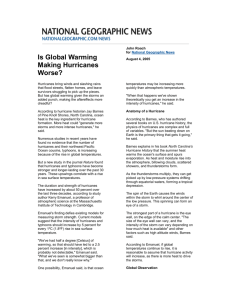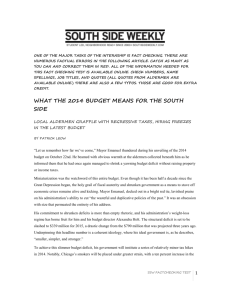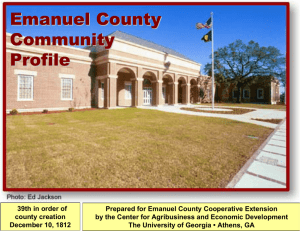Tropical Cyclones: When Shit Hits the Fan
advertisement
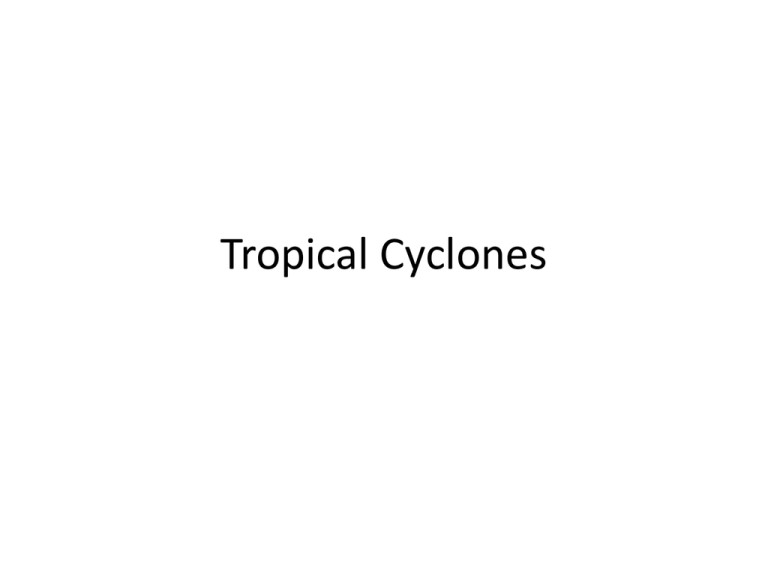
Tropical Cyclones 3D Structure Let’s Talk Genesis! Review • Nolan, Rappin, and Emanuel 2007; Khairoutdinov and Emanuel 2013; Zhuo, Held, and Garner 2014: TC genesis can occur on f-plane without a pre-existing cyclonic disturbance through: (1) self-aggregation (Radiative-Convective Feedback) (2) week circulations induced by convection develop into TCs. Khairoutdinov and Emanuel 2013 • Nolan and Rappin 2008 (and many others): Pre-existing disturbance is necessary for TC genesis. • Tropical disturbances such as easterly waves, Monsoon trough exhibit mid-level vorticity (Bister and Emanuel 1997; Raymond et al. 1998). • Development of strong near-surface vorticity and the associated warm core is a key element of tropical cyclone spinup. • Merging between two vorticies through vertical extention to the surface (Simpson et al. 1997; Ritchie and Holland 1997) unclear how! • Cool moist environment serves as incubation for low level warm core vortex (Bister and Emanuel 1997; Raymond and Sessions 2007). Raymond and Sessions 2007; GRL: the role of deep convection By cooling the lower troposphere and warming the upper troposphere, maximum convective mass flux lowers from 10 Km to 5 Km, intensifying the low-level inflow into the convection. Montgomery, Dunkerton, Wang 2008; Dunkerton et al. 2009: Pouch in a wave critical layer Stable Unstable Montgomery, Dunkerton, Wang 2008 Raymond and Lopez 2010 : Vorticity bugdet of Nuri 2008 and effect of shear Displacement of the vortices due to the vertical wind shear Intensification of Nuri through lowering the vertical mass flux Wang 2014; JAS: the role of cumulus congestus Mass Flux Moisture Flux Condensation solid: pregenesis; dashed: postgenesis black: congestus; red: deep convection Cumulus congestus plays a dominant role in moistening the lower to mid troposphere prior to genesis, through a bottom heavy mass flux (low level inflow), but deep convection intensify the vortex and extends it thought out the troposphere. Tropical Cyclone as a Heat Engine Entropy decrease isothermally Entropy increase at const. T Mechanical dissipation ~ rCD V VPot 2 3 = Heat (power) generation ~ r Ts - T0 Ck V (hs* - h* ) T0 Ck Ts - T0 * = (hs - h * ) CD T0 Emanuel 1986; Bister and Emanuel 1998 Terminology • Tropical storm: maximum sustained surface wind speed 18 – 33 m/s. • Hurricane or Typhoon: > 33 m/s. Saffir-Simposon Scale for Hurricanes Categories: Category Surface Wind Speed (m/s) 1 33 - 43 2 43 - 50 3 50 - 56 4 56 - 67 5 > 67 Tropical Cyclone Activity SST trends for the tropical cyclone season in each ocean basin Tropical ocean SSTs increased by approximately 0.5°C between 1970 and 2004 Global Frequency of TCs in a Warming Environment (1970 - 2004): • No statistically significant trend! • Decadal oscillations are evident Regional Frequency of TCs in a Warming Environment (1970 - 2004): Statistically significant trend only in the North Atlantic! Hurricanes Intensity in a Warming Climate (global) The horizontal dashed lines show the 1970–2004 average numbers in each category. • Cat: 1, and 2+3 hurricanes have remained approximately constant. Cat:1 had decreased in portion. • hurricanes in the strongest cat. (4 + 5) have almost doubled in number and portion. Power Dissipation Index as a Measure of TC Activity t PDI º ò V 3 Max dt 0 3 VMax t : maximum sustained surface wind speed (usually taken at 10 m height). : Life time of the storm. PDI is a better measure of TC threat than frequency alone or intensity alone. Emanuel 2005 r 2 = 0.63 r = 0.65 2 • Strong relationship between regional SST and PDI. • Multi-decadal and internal variability are evident. • Upward trend in the last decade is unprecedented and might reflect the effect of global warming. r 2 = 0.69 Chan 2005 in reply to Webster et al. 2005 No Trend in the West North Pacific! Emanuel 2007 is a correct version of Emanuel 2005 ! After bias correction: correlation in NA but not in WNP. Thermodynamic Influence on TCs 1- Moist convection (Raymond 1995): 1 éCk V (h0* - h * ) gQR ù Mu = ê ú * 1 - ge ë (h - hm ) S û 2- Mid-tropospheric humidity: 3- Potential Intensity: h0* - h * c= * h - hm VPot 2 = Ck Ts - T0 * (h0 - h * ) CD T0 Correlation between SST with various thermodynamic quantities: Emanuel et al. 2013 Response of TC Activity to PI Increase • GCM Simulations: Resolution too coarse to resolve the full intensity. • Downscaling Technique: Regional models nested in GCMs that provide boundary condition. Still coarse and expensive to conduct. Downscaling (Emanuel et al. 2006; Emanuel 2006; Emanuel et al. 2008) 1- Genesis: random drawing from probability distribution based on historical data. 2-Tracks: Beta-Advection model. 3-Intensity Model: CHIPS (Emanuel et al. 2004) Comparison between CHIPS and Best Track: Hurricane Katrina Comparison between CHIPS and Beast Track: PDF of frequency Emanuel 2006 Potential Intensity 10% increment There is a large increase in the frequency of high intensity events PDF of PDI with respect to Wind Speed •Higher potential intensity shifts the distribution toward more intense events. •65% increase over the control as observed! Vertical Wind Shear 10% increment Mixed Layer Depth 10% increment Downscaling from Reanalysis and AGCMS: Effect of Outflow Temperature San Juan soundings Larger differences in outflow temperature trends are accompanied by larger errors in downscaled power dissipation trends! Emanuel et al. 2013 Poleward Migration of TC Maximum Intensity Location Shear PI Kossin et al. 2014, Nature Resolved Convection is the Key? Current state of research on TC and Climate using GCMs: Walsh et al. 2015: Hurricanes and Climate: the U.S. CLIVAR Working Group oh Hurricanes. Contribution to PI •56% of the increase of PI in the North Atlantic over the past 30 years is owing to an increase in thermodynamic efficiency. •SST contributes to only 7% of the thermodynamic efficiency, the rest comes from the outflow temperature! Emanuel et al. 2013
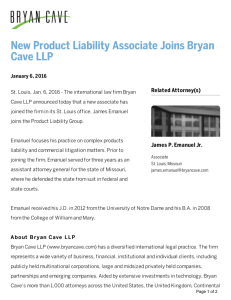
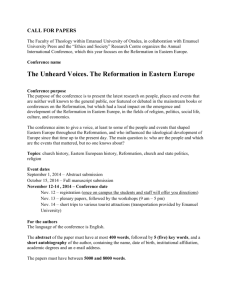
![[PowerPoint 2007] presentation file](http://s2.studylib.net/store/data/005406460_1-7834316c409f9802f7aec3d8538324fb-300x300.png)
